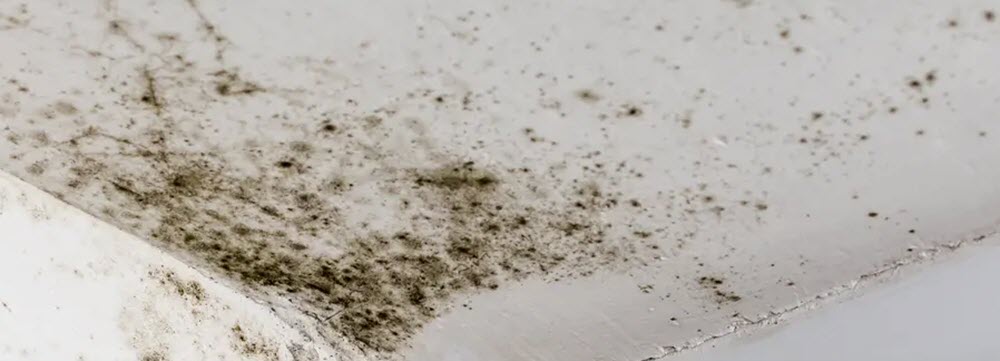If you notice a major black mold infestation in your house, or if it is in a place that is hard to get to, it is usually a good idea to get in touch with your home insurance company before you proceed. They can provide you with guidance regarding which type of black mold removal choices that would be covered by the insurance.
For milder infestations, you may be able to nip the problem in the bud by removing the mold yourself – following the safety procedures – and then take preventative measures to prevent a re-infestation. This is especially true for mold in locations where it is easy for you to correctly identify exactly how large the infestation is.
In this article, we will take a look at what black mold is, why it is something that home owners need to be aware of and how to reduce the risk of black mold infestations in your home.

What is black mold?
Several different species of fungus is known as black mold in colloquial English, but in the context of infested homes, the most common culprit is Stachybotrys chartarum.
Note: The black mold Aspergillus niger is more likely to infest fruits and vegetables, while the black mold Rhizopus stolonifer likes to grow on bread.
Stachybotrys chartarum
- Stachybotrys chartarum is a microfungus.
- Just like the name implies, it usually looks black, although it can also be of a greenish colour.
- This is a slow-growing mold.
- Stachybotrys chartarum is not very good at competing with other molds.
- The species was first identified by the the Czech mycologist August Carl Joseph Corda in 1837, from a colony growing on the wall of the house in Prague.
Preventing black mold infestations in your home
The first step to preventing Stachybotrys chartarum black mold infestations in your home is to understand what this fungus wants. Then, you can take steps to avoid having environments in your home where these wants are fulfilled.
Stachybotrys chartarum occurs in the wild, and have been identified in soil and grain, but what it really low is cellulose-rich material. It therefore grows very well in cellulose-rich building materials such as drywalls and wallpaper. Access to cellulose-rich materials is not enough, however, as the fungus also needs moist. The combination of cellulose and moist is therefore something to be avoided if you want to prevent an infestation.
Inadvertently, we humans often create living environments that are rare in the wild but ideal for black mold, such as an environment that is rich in cellulose, low in nitrogen, free from competing molds, free from sunlight, and where there is plenty of humidity and the substrate never dries out completely as it is not exposed to sunlight and wind. S. chatarum prefers the temperature range 40-100 degrees F (4.5 – 38 degrees C).
Prevention
- Make sure that the environment is dry where there are cellulose-rich materials, such as dry walls, wall paper, building paper, cotton fabrics, and cellulose insulation.
- Make sure that environments that are damp or moist do not contain cellulose-rich materials. This includes damp basements, bathrooms with inadequate ventilation and outdoor areas.
- Keep the air humidity below 70%.
- Treat high-risk areas with anti-fungal treatments suitable for home use.
- Be vigilant about leaks. Investigate any signs of a leak in your home, even if the signs are mild. This includes both water-pipe leaks and leaks that allow rainwater to enter.
- Quickly repair any leaks, and investigate the surrounding area for signs of mold.
- Be vigilant about water condensation. This happens when warmer air (which can carry a lot of moist) is cooled down (and therefore can not carry the same amount of moist anymore).
- If the house has been flooded, endured a major water leak or something else out of the ordinary that involves unusual exposure to water and/or moist, contact the insurance company for more information about preventative measures.
Spores
S. chartarum spreads through spores. Large amounts of spores can be released into the air when the mold is mechanically disturb, especially if the mold is also wet.
Many people who are sensitive to black old is actually sensitive to the airborne spores, not to the mold itself.
Scientific classification of Stachybotrys chartarum
| Kingdom: | Fungi |
| Division: | Ascomycota |
| Class: | Sordariomycetes |
| Order: | Hypocreales |
| Family: | Stachybotryaceae |
| Genus: | Stachybotrys |
| Species: | Stachybotrys chartarum |
Health issues
Stachybotrys chartrum is sometimes referred to as “toxic mold”, but there is no evidence of this mold being especially toxic compared to many other molds. That doesn´t meant that it is harmless; just that it is not some kind of super-dangerous mold that is worse than all the other molds.
There are a wide range of molds that can cause symptoms in people who are sensitive or allergic, or who has to endure usually strong and/or prolonged exposure.
Two chemotypes of mycotoxin producing S. chartrum have been identified.
- One chemotype that produces trichothecen mycotoxins, such as satratoxin.
- One chemotype that produces atranones, which are also toxic to humans but not as toxic as the trichothecen mycotoxins.
There are strains of S. chartarum that do not produce mycotoxins, and researchers have also been able to observe strains that lose their ability to produce mycotoxins over time.
Allergic symptoms
Examples of common symptoms of black mold allergy:
- Problems with the nose, such as runny nose, stuffed nose, sneezing and/or itchy nose
- Itchy eyes
- Itchy throat
- Dry, scaly skin
Examples of common symptoms of mold-induced asthma:
- Shortness of breath
- Wheezing
- Coughing
- Chest tightness